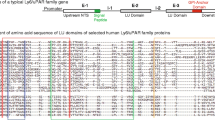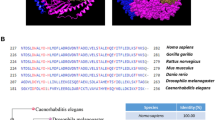Abstract
Members of the Ly-6 (Lymphocyte Antigen 6) protein family share one or several repeat units of the LU domain that is defined by a distinct disulfide bonding pattern between 8 or 10 cysteine residues. Here we report the cloning and characterization of a novel human LU domain-containing gene, LYPD7 (LY6/PLAUR domain containing 7), isolated from human testis cDNA library, and mapped to 2q22.3–23.3 by searching the UCSC genomic database. The LYPD7 cDNA sequence consists of 1,600 nucleotides and contains an open reading frame of 624 bp, encoding a putative protein of 207 amino acid residues. RT-PCR analysis showed that LYPD7 was especially highly expressed in testis, lung, stomach, and prostate. Subcellular localization of LYPD7 demonstrated that the protein was localized in the cytoplasm when overexpressed in Hela cells. Furthermore, the subsequent analysis based on reporter gene assays suggested that overexpression of LYPD7 in HEK 293T cells was able to activate the transcriptional activities of AP1 (PMA).





Similar content being viewed by others
Abbreviations
- Ly-6:
-
(Lymphocyte Antigen 6)
- LU domain:
-
Ly-6 antigen/uPA receptor-like domain
- LYPD7 :
-
LY6/PLAUR domain containing 7
- GPI:
-
Glycophosphatidyl inositol
- PMA:
-
Phorbol myristate acetate
References
LeClair KP, Rabin M, Nesbitt MN, Pravtcheva D, Ruddle FH, Palfree RG, Bothwell A (1987) Murine Ly-6 multigene family is located on chromosome 15. Proc Natl Acad Sci 84(6):1638–1642
LeClair KP, Palfree RG, Flood PM, Hammerling U, Bothwell A (1986) Isolation of a murine Ly-6 cDNA reveals a new multigene family. EMBO J 5:3227–3234
Bamezai A (2004) Mouse Ly-6 proteins and their extended family: markers of cell differentiation and regulators of cell signaling. Archivum Immunologiae et Therapiae Experimentalis 52:255–266
Ploug M, Kjalke M, Rønne E, Weidle U, Høyer-Hansen G, Danø K (1993) Localization of the disulfide bonds in the NH2-terminal domain of the cellular receptor for human urokinase-type plasminogen activator. A domain structure belonging to a novel superfamily of glycolipid-anchored membrane proteins. J Biol Chem 268(23):17539–17546
Ploug M, Ellis V (1994) Structure-function relationships in the receptor for urokinase-type plasminogen activator. Comparison to other members of the Ly-6 family and snake venom alpha-neurotoxins. FEBS Lett 349:163–168
Stroncek DF, Caruccio L, Bettinotti M (2004) CD177: a member of the Ly-6 gene superfamily involved with neutrophil proliferation and polycythemia vera. J Transl Med 2:8
Plesner T, Behrendt N, Ploug M (1997) Structure, function and expression on blood and bone marrow cells of the urokinase-type plasminogen activator receptor, uPAR. Stem Cells 15:398–408
Ruud H Brakenhoff, Martijn Gerretsen, Ellen MC, Knippels, Mirjam van Dijk, Huib van Essen, Danie1 Olde Weghuis, Richard J Sinke, Gordon B Snow, Guus A MS van Dongen (1995) The human E48 antigen, highly homologous with the murine Ly-6 antigen ThB, is a GPI-anchored molecule apparently involved in keratinocyte cell–cell adhesion. J Cell Biol 129:1677–1689
Shan X, Bourdeau A, Rhoton A, Wells DE, Cohen EH, Landgraf BE, Palfree RG (1998) Characterization and mapping to human chromosome 8q24.3 of Ly-6-related gene 9804 encoding an apparent homologue of mouse TSA-1. J Immunol 160:197–208
Adermann K, Wattler F, Wattler S, Heine G, Meyer M, Forssmann WG, Nehls M (1999) Structural and phylogenetic characterization of human SLURP-1, the first secreted mammalian member of the Ly-6/uPAR protein superfamily. Protein Sci 8:810–819
Tsuji H, Okamoto K, Matsuzaka Y, Iizuka H, Tamiya G, Inoko H (2003) SLURP-2, a novel member of the human Ly-6 superfamily that is up-regulated in psoriasis vulgaris. Genomics 81:26–33
Davies A, Simmons DL, Hale G, Harrison RA, Tighe H, Lachmann PJ, Waldmann H (1989) CD59, an LY-6-like protein expressed in human lymphoid cells, regulates the action of the complement membrane attack complex on homologous cells. J Exp Med 170:637–654
Tarui T, Mazar AP, Cines DB, Takada Y (2001) Urokinase-type plasminogen activator receptor (CD87) is a ligand for integrins and mediates cell-cell interaction. J Biol Chem 276:3983–3990
Schrijvers A erretsen M, Fritz JM, van Walsum M, Quak JJ, Snow GB, van Dongen GA (1991) Evidence for a role of the monoclonal antibody E48 defined antigen in cell–cell adhesion in squamous epithelia and head and neck squamous cell carcinoma. Exp Cell Res 196:264–269
Miwa JM, Ibanez-Tallon I, Crabtree GW, Sanchez R, Sali A, Role LW, Heintz N (1999) Lynx1, an endogenous toxin-like modulator of nicotinic acetylcholine receptors in the mammalian CNS. Neuron 23:105–114
Westbrook VA, Farris EM, Hao Z, Coonrod SA, Flickinger CJ, Herr JC (2003) SAMP14, a novel, acrosomal membrane-associated, glycosyl phosphatidylinositol-anchored member of the Ly-6/urokinase-type plasminogen activator receptor superfamily with a role in sperm–egg interaction. J Biol Chem 278:30506–30515
Reiter RE, Gu Z, Watabe T, Thomas G, Szigeti K, Davis E, Wahl M, Nisitani S, Yamashiro J, Le Beau MM, Loda M, Witte ON (1998) Prostate stem cell antigen: a cell surface marker overexpressed in prostate cancer. Proc Natl Acad Sci 95:1735–1740
Dumont FJ, Altmeyer A, Staruch MJ, Dijkmans R, Palfree RG, Fischer PA (1990) Role of protein kinase C in IFN-mediated Ly-6E antigen induction. J Immunol 144:3795–3803
HogenEsch H, de Geus B, Tielen F, Rozing J (1993) Constitutive expression of Ly-6.A2 on murine keratinocytes and inducible expression on TCR γδ + dendritic epidermal T cells. J Dermatol Sci5:114–121
Acknowledgments
This work was supported by the National 973 program of China, 863 projects of China and the National Natural Science foundation of China (30024001).
Author information
Authors and Affiliations
Corresponding author
Additional information
Sequence date from this article has been deposited with the GenBank Data Library under Accession No.NM177964.
Rights and permissions
About this article
Cite this article
Ni, J., Lang, Q., Bai, M. et al. Cloning and characterization of a human LYPD7, a new member of the Ly-6 superfamily. Mol Biol Rep 36, 697–703 (2009). https://doi.org/10.1007/s11033-008-9231-6
Received:
Accepted:
Published:
Issue Date:
DOI: https://doi.org/10.1007/s11033-008-9231-6




